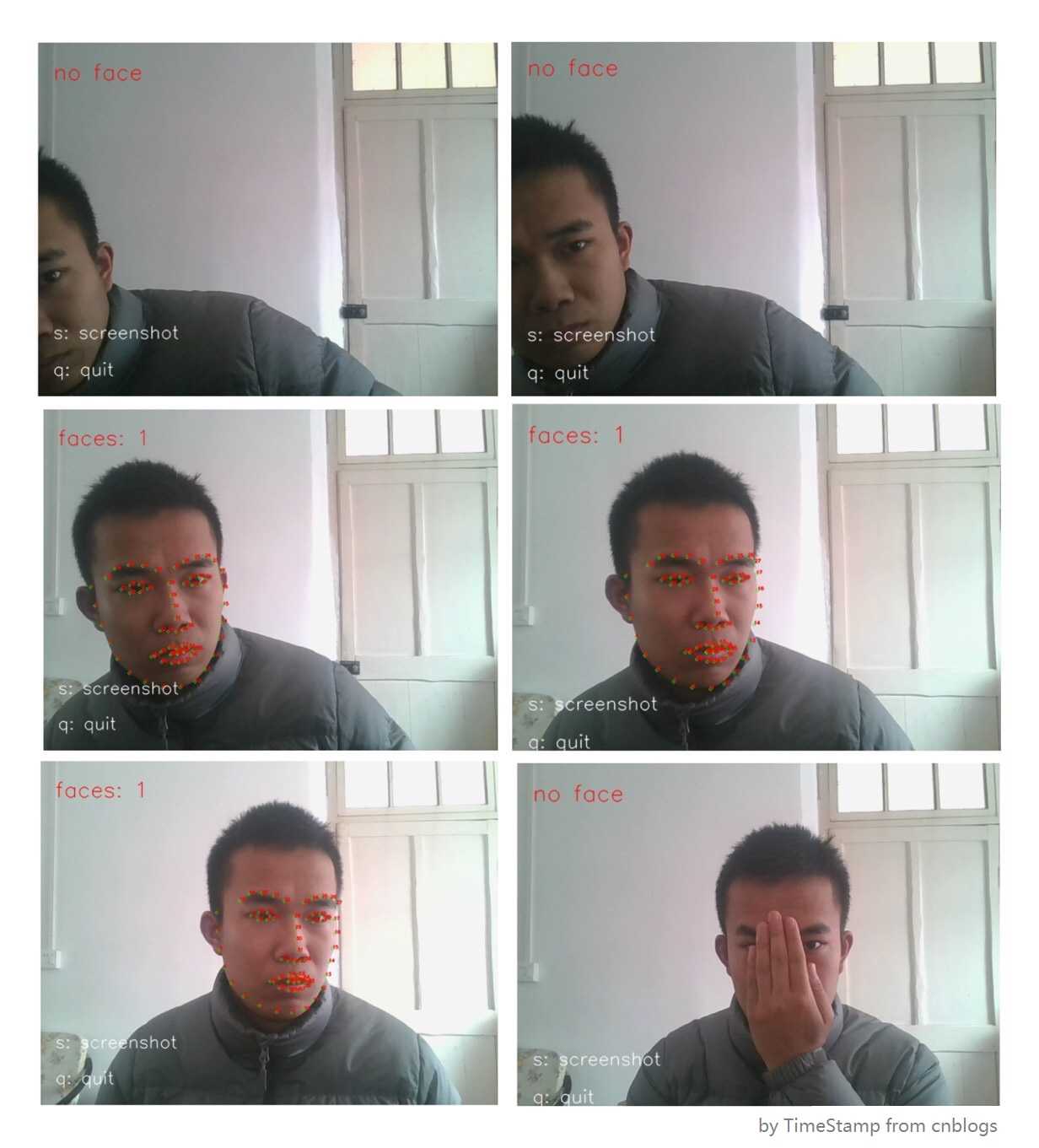0.引言
利用python开发,借助Dlib库捕获摄像头中的人脸,进行实时特征点标定;

图1 工程效果示例(gif)

图2 工程效果示例(静态图片)
(实现比较简单,代码量也比较少,适合入门或者兴趣学习。)
1.开发环境
python: 3.6.3
dlib: 19.7
OpenCv, numpy
1 import dlib # 人脸识别的库dlib 2 import numpy as np # 数据处理的库numpy 3 import cv2 # 图像处理的库OpenCv
2.源码介绍
其实实现很简单,主要分为两个部分:摄像头调用+人脸特征点标定
2.1 摄像头调用
介绍下opencv中摄像头的调用方法;
利用 cap = cv2.VideoCapture(0) 创建一个对象;
(具体可以参考官方文档:https://docs.opencv.org/2.4/modules/highgui/doc/reading_and_writing_images_and_video.html)
1 # 2018-2-26 2 # By TimeStamp 3 # cnblogs: http://www.cnblogs.com/AdaminXie 4 5 """ 6 cv2.VideoCapture(), 创建cv2摄像头对象/ open the default camera 7 8 Python: cv2.VideoCapture() → <VideoCapture object> 9 10 Python: cv2.VideoCapture(filename) → <VideoCapture object> 11 filename – name of the opened video file (eg. video.avi) or image sequence (eg. img_%02d.jpg, which will read samples like img_00.jpg, img_01.jpg, img_02.jpg, ...) 12 13 Python: cv2.VideoCapture(device) → <VideoCapture object> 14 device – id of the opened video capturing device (i.e. a camera index). If there is a single camera connected, just pass 0. 15 16 """ 17 cap = cv2.VideoCapture(0) 18 19 20 """ 21 cv2.VideoCapture.set(propId, value),设置视频参数; 22 23 propId: 24 CV_CAP_PROP_POS_MSEC Current position of the video file in milliseconds. 25 CV_CAP_PROP_POS_FRAMES 0-based index of the frame to be decoded/captured next. 26 CV_CAP_PROP_POS_AVI_RATIO Relative position of the video file: 0 - start of the film, 1 - end of the film. 27 CV_CAP_PROP_FRAME_WIDTH Width of the frames in the video stream. 28 CV_CAP_PROP_FRAME_HEIGHT Height of the frames in the video stream. 29 CV_CAP_PROP_FPS Frame rate. 30 CV_CAP_PROP_FOURCC 4-character code of codec. 31 CV_CAP_PROP_FRAME_COUNT Number of frames in the video file. 32 CV_CAP_PROP_FORMAT Format of the Mat objects returned by retrieve() . 33 CV_CAP_PROP_MODE Backend-specific value indicating the current capture mode. 34 CV_CAP_PROP_BRIGHTNESS Brightness of the image (only for cameras). 35 CV_CAP_PROP_CONTRAST Contrast of the image (only for cameras). 36 CV_CAP_PROP_SATURATION Saturation of the image (only for cameras). 37 CV_CAP_PROP_HUE Hue of the image (only for cameras). 38 CV_CAP_PROP_GAIN Gain of the image (only for cameras). 39 CV_CAP_PROP_EXPOSURE Exposure (only for cameras). 40 CV_CAP_PROP_CONVERT_RGB Boolean flags indicating whether images should be converted to RGB. 41 CV_CAP_PROP_WHITE_BALANCE_U The U value of the whitebalance setting (note: only supported by DC1394 v 2.x backend currently) 42 CV_CAP_PROP_WHITE_BALANCE_V The V value of the whitebalance setting (note: only supported by DC1394 v 2.x backend currently) 43 CV_CAP_PROP_RECTIFICATION Rectification flag for stereo cameras (note: only supported by DC1394 v 2.x backend currently) 44 CV_CAP_PROP_ISO_SPEED The ISO speed of the camera (note: only supported by DC1394 v 2.x backend currently) 45 CV_CAP_PROP_BUFFERSIZE Amount of frames stored in internal buffer memory (note: only supported by DC1394 v 2.x backend currently) 46 47 value: 设置的参数值/ Value of the property 48 """ 49 cap.set(3, 480) 50 51 """ 52 cv2.VideoCapture.isOpened(), 检查摄像头初始化是否成功 / check if we succeeded 53 返回true或false 54 """ 55 cap.isOpened() 56 57 """ 58 cv2.VideoCapture.read([imgage]) -> retval,image, 读取视频 / Grabs, decodes and returns the next video frame 59 返回两个值: 60 一个是布尔值true/false,用来判断读取视频是否成功/是否到视频末尾 61 图像对象,图像的三维矩阵 62 """ 63 flag, im_rd = cap.read()
2.2 人脸特征点标定
调用预测器“shape_predictor_68_face_landmarks.dat”进行68点标定,这是dlib训练好的模型,可以直接调用进行人脸68个人脸特征点的标定;
具体可以参考我的另一篇博客(http://www.cnblogs.com/AdaminXie/p/8137580.html);
2.3 源码
实现的方法比较简单:
利用 cv2.VideoCapture() 创建摄像头对象,然后利用 flag, im_rd = cv2.VideoCapture.read() 读取摄像头视频,im_rd就是视频中的一帧帧图像;
然后就类似于单张图像进行人脸检测,对这一帧帧的图像im_rd利用dlib进行特征点标定,然后绘制特征点;
你可以按下s键来获取当前截图,或者按下q键来退出摄像头;
1 # 2018-2-26 2 # By TimeStamp 3 # cnblogs: http://www.cnblogs.com/AdaminXie 4 # github: https://github.com/coneypo/Dlib_face_detection_from_camera 5 6 import dlib #人脸识别的库dlib 7 import numpy as np #数据处理的库numpy 8 import cv2 #图像处理的库OpenCv 9 10 # dlib预测器 11 detector = dlib.get_frontal_face_detector() 12 predictor = dlib.shape_predictor(‘shape_predictor_68_face_landmarks.dat‘) 13 14 # 创建cv2摄像头对象 15 cap = cv2.VideoCapture(0) 16 17 # cap.set(propId, value) 18 # 设置视频参数,propId设置的视频参数,value设置的参数值 19 cap.set(3, 480) 20 21 # 截图screenshoot的计数器 22 cnt = 0 23 24 # cap.isOpened() 返回true/false 检查初始化是否成功 25 while(cap.isOpened()): 26 27 # cap.read() 28 # 返回两个值: 29 # 一个布尔值true/false,用来判断读取视频是否成功/是否到视频末尾 30 # 图像对象,图像的三维矩阵 31 flag, im_rd = cap.read() 32 33 # 每帧数据延时1ms,延时为0读取的是静态帧 34 k = cv2.waitKey(1) 35 36 # 取灰度 37 img_gray = cv2.cvtColor(im_rd, cv2.COLOR_RGB2GRAY) 38 39 # 人脸数rects 40 rects = detector(img_gray, 0) 41 42 #print(len(rects)) 43 44 # 待会要写的字体 45 font = cv2.FONT_HERSHEY_SIMPLEX 46 47 # 标68个点 48 if(len(rects)!=0): 49 # 检测到人脸 50 for i in range(len(rects)): 51 landmarks = np.matrix([[p.x, p.y] for p in predictor(im_rd, rects[i]).parts()]) 52 53 for idx, point in enumerate(landmarks): 54 # 68点的坐标 55 pos = (point[0, 0], point[0, 1]) 56 57 # 利用cv2.circle给每个特征点画一个圈,共68个 58 cv2.circle(im_rd, pos, 2, color=(0, 255, 0)) 59 60 # 利用cv2.putText输出1-68 61 cv2.putText(im_rd, str(idx + 1), pos, font, 0.2, (0, 0, 255), 1, cv2.LINE_AA) 62 cv2.putText(im_rd, "faces: "+str(len(rects)), (20,50), font, 1, (0, 0, 255), 1, cv2.LINE_AA) 63 else: 64 # 没有检测到人脸 65 cv2.putText(im_rd, "no face", (20, 50), font, 1, (0, 0, 255), 1, cv2.LINE_AA) 66 67 # 添加说明 68 im_rd = cv2.putText(im_rd, "s: screenshot", (20, 400), font, 0.8, (255, 255, 255), 1, cv2.LINE_AA) 69 im_rd = cv2.putText(im_rd, "q: quit", (20, 450), font, 0.8, (255, 255, 255), 1, cv2.LINE_AA) 70 71 # 按下s键保存 72 if (k == ord(‘s‘)): 73 cnt+=1 74 cv2.imwrite("screenshoot"+str(cnt)+".jpg", im_rd) 75 76 # 按下q键退出 77 if(k==ord(‘q‘)): 78 break 79 80 # 窗口显示 81 cv2.imshow("camera", im_rd) 82 83 # 释放摄像头 84 cap.release() 85 86 # 删除建立的窗口 87 cv2.destroyAllWindows()
# 请尊重他人劳动成果,转载或者使用源码请注明出处:http://www.cnblogs.com/AdaminXie
# 如果对您有帮助,欢迎在GitHub上star本项目: https://github.com/coneypo/Dlib_face_detection_from_camera
